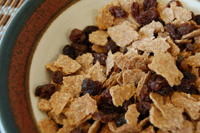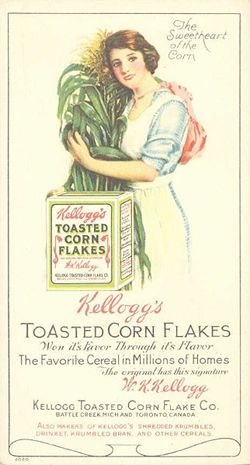Kellogg’s is also known for another food first: in 1984, it became the first company to include a health claim on its packaging. At the time, the practice was forbidden by the FDA. But instead of telling Kellogg’s to remove the claim — which suggested that eating All-Bran could possibly reduce the occurrence of some cancers — the Regan Administration’s FDA reconsidered their stance. In 1986, Marian Burros wrote about the change in The New York Times:
Why did the F.D.A. rethink this approach? According to Bruce Brown, an agency press officer: ”A byproduct of the Administration’s interest in deregulation is an interest in cutting medical costs. Broadly construed, the use of health claims on labels would help people maintain their own health.”
I get tickled reading this now, 23 years later, when health care is at the fore of American thought and we’re more obese than ever, and a cereal like Froot Loops can today list sugar as its most plentiful ingredient, but still paste the front of its box with “Now provides fiber: a great way to keep kids healthy.”
It’s health discrepancies like the fiber in Froot Loops that lead us to occasional magazine and newspaper articles here in the U.S. that deconstruct cereal health claims, usually coupled with taste tests and nutritionist’s rankings. But over in Europe, the cereal-health-claim debate has been heating up — the EU is currently considering a law that would tighten regulations on the claims cereal manufacturers can make. In a recent article in London’s Times on the potential legislation, one of the unhealthy cereal examples featured wasn’t necessarily one you’d expect, though: It was Kellogg’s Bran Flakes, a cereal similar to Kellogg’s American bran offerings. According to the article, while the cereal has plenty of digestive-healthy fiber, it also contains “22 per cent sugar.”
Huh. I guess Kellogg’s isn’t just flattening stale wheat anymore.
So if cereal boxes are so misleading and even “good” cereals include ingredients that detract from their health benefits, why are we still so obsessed with cereal? There are, of course, a variety of answers: Cereal tastes good, and it’s incredibly convenient – what’s faster than adding flakes and milk to a bowl in the morning? The aforementioned health claims and other marketing certainly help, too. But I think there’s also another piece: We’re willing to ignore cereal’s sins because we can’t make it ourselves. There’s a certain amount of dark arts that goes into the production of most cereals, granola and muesli aside, some factory magic that can’t easily be replicated in a home kitchen. Even the most dedicated home chefs don’t Krisp their own rice, shape oat bran into Cheerios, or figure out how to hatch-pattern and hollow-out tiny Chex. In recipes, boxed cereals are considered a base ingredient to start from, not something to make on their own. It’s best for us to just accept what we’re offered and move on.
This is why I was surprised when I recently found a delicious, low-sugar recipe for bran flakes. I discovered it on Big Oven, a recipe-sharing site, and whoever posted it there claimed it originally came from a “1978 Mormon homemaking booklet.” When I tried searching for the original booklet, I found a somewhat similar recipe in a 1978 Church of Jesus Christ of Latter-day Saints publication called Essentials of Home Production and Storage. This book was produced to guide church members in stockpiling food, clothing, and other supplies for emergencies. Thus even when there is a recipe for bran flakes available, it’s intended only for use in emergency, when you literally can’t leave your house to buy new food.
It’s not exactly a convenience food, but I like to think that W.K. Kellogg would be proud. • 10 September 2009
| Bran Flakes, adapted from anonymously posted recipe on Big Oven |
 As the only one in my house who eats cereal, I often find the end of a box stale before I ever get to it. To avoid that problem, this recipe makes approximately four servings of bran flakes, but it can easily be doubled. As the only one in my house who eats cereal, I often find the end of a box stale before I ever get to it. To avoid that problem, this recipe makes approximately four servings of bran flakes, but it can easily be doubled.
1 cup wheat bran Preheat oven to 350 degrees. Mix dry ingredients, then make a well in the center and add wet ingredients. Divide the dough into four sections. Put the first section of dough on a piece of parchment and roll it as thin as you can. Transfer the parchment to a baking sheet and bake until the edges start to brown. Once the edges have browned, remove the bran sheet from the oven, rip the toasted ends off, put them on a baking sheet to cool, flip the bran sheet, and put it back in the oven. When the edges have toasted again, remove the sheet from the oven, put the edges on the drying rack, and rip the rest of the bran sheet into flakes. Place back in oven until all flakes are toasted. Repeat with other dough sections. After flakes have cooled, store in an airtight container. Add a handful of raisins just before eating if desired. Note: The bran sheet will be hot when it comes out of the oven. I used a flour-sack towel to hold the bran sheet while ripping. |




